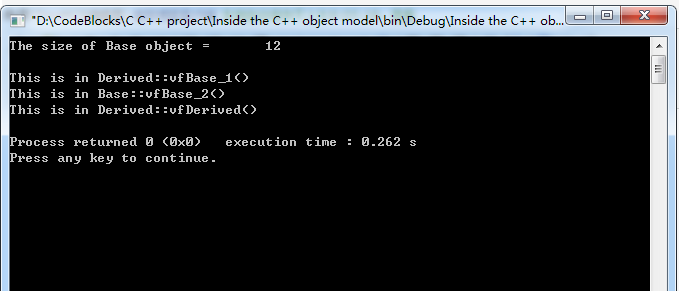内容概要:
满足下面2个条件时,
1. 父类有虚函数,子类也有虚函数,且子类的虚函数重写或覆盖了父类的虚函数
2. 非虚继承
类对象之内存布局
在前面的例子中,恢复原来的两个虚函数vfBase_1()和vfBase_2(),同时在Derived类中重写基类的虚函数vfBase_1(),Base类和Derived类之间的关系如下图:

整个代码如下:
#include <iostream> using namespace std; class Base { public: int m_base; inline virtual void vfBase_1() { cout << "This is in Base::vfBase_1()" << endl; } inline virtual void vfBase_2() { cout << "This is in Base::vfBase_2()" << endl; } }; class Derived : public Base { public: int m_derived; inline virtual void vfDerived() { cout << "This is in Derived::vfDerived()" << endl; } inline void vfBase_1() { cout << "This is in Derived::vfBase_1()" << endl; } }; typedef void (*VFun)(void); // 改为template形式,因为不能确定传进来的参数是Base类型的指针还是Derived类型的指针 template<typename T> VFun virtualFunctionPointer(T* b, int i) { return (VFun)(*((int*)(*(int*)b) + i)); } int main(void) { Derived d; cout << "The size of Base object = " << sizeof(Derived) << endl; cout << endl; int i = 0; while(virtualFunctionPointer(&d, i)) { VFun pVF = virtualFunctionPointer(&d, i++); pVF(); } return 0; }
运行结果:

Derived 对象的memory layout图解如下:

因为Derived类中重写了虚函数vfBase_1(),所以Derived::vfBase_1()就取代了Base::vfBase_1()的位置,位于虚函数表的开始处。而Base::vfBase_1()就不会再在Derived的虚函数表中出现了。